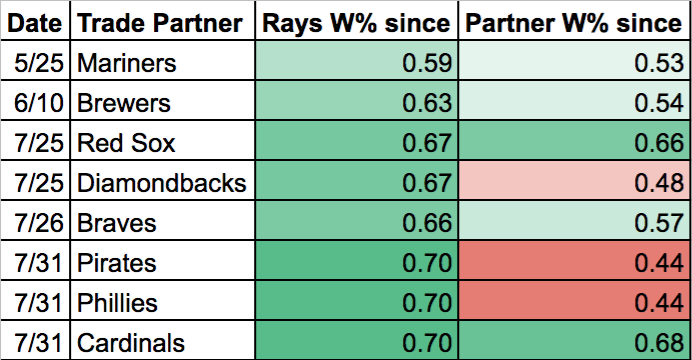Do The Rays Know It?
- Dylan Anderson

- Sep 11, 2018
- 5 min read

The Tampa Bay Rays began selling ahead of schedule. FanGraphs gave the Rays a 6.7% chance to make the postseason on Opening Day with a projected win total of 76. They were going nowhere. So why wait?
On May 25, they sent closer Alex Colome and outfielder Denard Span to the Seattle Mariners. At the time, the move seemed logical enough for both teams; the 23-26 Rays moving a pair of useful veterans to aid the 30-20 Mariners in their quest for a playoff berth. From afar, the transaction seemingly symbolized the Rays’ early forfeiture of 2018 in favor of long-term optimism. It’s a necessity all too familiar for small markets like Tampa Bay who operate payrolls near the bottom of the league.
Fast-forward to September 11th. The rebuilding Rays and the contending Mariners have the exact same record. Both are 79-64.
The Span and Colome deal foreshadowed an eventual trend of the Rays trading what feels like an entire lineup of solid contributors to contending teams, only to outplay them after the fact.
Tampa Bay would go on to make deals with playoff hopefuls Pittsburgh, Arizona, Philadelphia, Atlanta, St. Louis, Milwaukee and Boston. Their trade partners share a commonality in that not one of them have won more games than the Rays between the date of their respective trades and today. Even the 98-46 Red Sox.

In fact, of Tampa Bay’s contending trade partners, only three have more wins on the season in Boston, Milwaukee and Atlanta. Of course, reducing all of these trades to a single fad ignores the nuances of each individual trade which warrant more narrow case studies of their own. These deals generally consisted of the Rays swapping major leaguers for minor leaguers, with the strange exception of the Cardinals essentially giving away Tommy Pham for some lesser prospects.
In perhaps the most significant deal, Tampa Bay ended years of will-they-or-won’t-they trade Chris Archer chatter by dealing their long-tenured ace while on a very team friendly contract. But in return they got major leaguers and former top prospects Tyler Glasnow and Austin Meadows in addition to Shane Baz, a surprisingly valuable player to be named later. Since the deal, Glasnow has outpitched Archer. Meadows has hit more homers in 27 games as a Rays farmhand than he did between the majors and minors for 91 games as a member of the Pittsburgh Pirates organization.
In two swaps for major leaguers who play the same position, Tampa Bay acquired Ji-Man Choi from Milwaukee for cash plus Brad Miller, and Jalen Beeks from the Red Sox for Nathan Eovaldi. Since, Miller has half the wRC+ of Choi while Eovaldi and Beeks have similar numbers.
How have the Rays won so many trades, even in the short term? Do they know something? Surely, luck played a role. And the timeframes for such analyses are too short to yield anything significant. But it’s safe to say that, with a competent roster and a pitching strategy seen only once before, the Rays operate unlike any other club in baseball.
…
A week before their 2018 fire sale began, the Rays started veteran relief pitcher and right-handed specialist Sergio Romo against an Angels lineup featuring just one lefty, a struggling Kole Calhoun in the 8th spot. Romo struck out the side in order, Ryan Yarbrough relieved him for 6.1 innings, the Rays won 5-3 and Alex Colome notched the save six days before being shipped to Seattle.
Fittingly in Los Angeles, the 21-22 Rays began writing a new pitching script, with Romo cast as “The Opener,” Yarbrough playing “The Headliner” and Chaz Roe, Ryne Stanek and Colome appearing as themselves.
Now 100 games into the experiment, the Rays are sticking with it. They’ve won 58 games since Romo’s start was announced, a 94-win pace or the exact same win pace as the National League leading Chicago Cubs.
After entering the season with four traditional starters and a fifth day of “Johnny Bullpen” in the rotation, the Rays kept Archer and Snell in their usual roles but saw their rotation gradually lose starters due to injuries and strategy until just Archer remained and was then traded, leaving the infamous image of a depth chart with nary a starting pitcher. Of course, Glasnow stepped into the rotation and Snell returned from the DL, and Tampa Bay now use a rotation consisting of those two and a patchwork of Diego Castillo, Stanek and other relievers to begin games.
The Rays are winning, but has this strategy worked? Since its introduction, the Rays 3.36 collective ERA ranks only behind the Dodgers’ 3.31 mark. The offense has been respectable with a 103 wRC+, good for ninth in baseball over that span. Using just these two metrics to say the Rays are top ten in run production and prevention would be a stretch; they’re 18th in runs scored and 16th in OPS since May 19th, but they are a team winning at an astounding clip given their payroll and unspectacular roster.
“The Opener” allows manager Kevin Cash to force certain parts of the game in his favor. The Rays can use an effective reliever in what amounts to a medium-leverage situation at a game’s outset. His follower, the headliner can face up to 24 hitters without incurring the third-time-through penalty against the other team’s top three batters. And without the commitment of a starting pitcher being expected to reach the game’s middle or late innings, the Rays can exploit matchups earlier in the game. The tactic can also be used to suppress salaries, as Yarbrough and others may fare worse in arbitration as headliners than starters, despite throwing innings similar to a starter’s workload.
It’s too early to formally conclude if The Opener is a surefire scheme, and it has its limitations such as the flexibility and willingness of pitchers to pitch in different roles. But while employing it, the Rays have allowed more than one fewer run per game than before. And it has caught on to some degree, with teams such as the Twins, Athletics, Dodgers and more giving the strategy a shot.
…
The baseball world has no choice but to take notice. The Rays started off with a dirt-cheap roster, traded many contributors and turned what should have been a lost season into what would be a playoff-worthy one in a less lopsided league. They have manufactured one of the league’s most productive pitching staffs despite 11 pitcher DL stints, six of which were over two months. Youngsters Brent Honeywell and Jose De Leon were expected to contribute, and both underwent Tommy John surgery before seeing the mound in the regular season.
The Rays won’t make the playoffs this year, though they might finish with a better record than the central division champion in what is an extremely top-heavy American League. Next year, they might play in October. They will need sustained success from what seems like a band of misfits. The cliche, though somewhat true for this club, overlooks the actual talent of a lineup featuring the likes of 28-year-old rookie Joey Wendle and an outfield composed of Kevin Kiermaier plus castaways Pham, Meadows and Mallex Smith. Sprinkle in Willy Adames, Daniel Robertson, Jake Bauers and Matt Duffy to backup a filthy pitching staff, and the Rays have hopefulness ahead.
It seems reasonable to expect the Rays to continue with the opener in 2019, with an even younger pitching staff that may eventually include Honeywell, De Leon and two-way prospect Brendan McKay. Will they extend the idea further, and move Snell and Glasnow into relief roles akin to Yarbrough’s? Will they tweak the strategy, perhaps eliminating pitching roles altogether and utilizing a deep staff in 2-4 inning bursts?
At the coattails of the wealthy Red Sox and Yankees, Tampa Bay pioneered a revolution in 2018 that drew mockery initially and certain envy by now. If all goes right, they could be eyeing a 100-win season a year from now while still third in their own division, playing in front of a nearly empty stadium. But that’s just based on what we know now. The Rays must have more tricks up their sleeve.









Comments